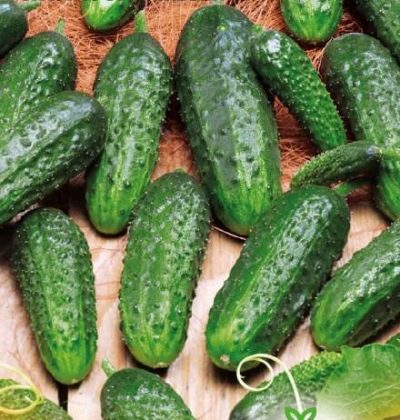
- Authors: BEJO ZADEN B.V. (Holland)
- Year of approval: 1998
- Growth type: medium-sized
- Fruit weight, g: 66-87
- Fruit color: green, with medium and long stripes, with medium mottling
- Cucumber Mosaic Virus Resistance: stable
- Ripening terms: early
- Pollination: bee-pollinated
- Fruit shape: cylindrical
- Fruit taste: good and great
Russian vegetable growers are happy to buy seeds from Dutch producers. This small state has large-scale achievements and experience in agriculture and seed production. There is no need to be afraid that foreign varieties are not suitable for our climatic conditions, because many of them are zoned and included in the State Register, for example, a cucumber with the sonorous name of the character of the European comics Asterix.
Breeding history
The medium-fruited hybrid of the first generation Asterix F1 was developed by the specialists of Bejo Zaden B. V. (Netherlands). It is a large seed company, known since 1912, one of the industry leaders in Europe and the world. The main activity is varieties and hybrids for open ground. Bejo has been cooperating with Russia since 1989. In the Russian Federation, the Asterix hybrid passed variety trials and since 1998 has been approved for cultivation in the Central and Central Black Earth Districts.
Description of the variety
Asterix is an early maturing bee-pollinated hybrid for unprotected soil. Differs in high productivity, immunity to diseases and pests, resistance to cold and drought periods, good adaptation to different climates. Medium-sized fruits weighing about 80 g have excellent taste and versatility.
Characteristics of the appearance of plants and zelents
Plant of medium height with a powerful stem, moderate branching and dark green, slightly wavy at the edge, slightly wrinkled leaves. Lateral lashes are long. The root part is well branched.
The flowers are mainly of the female type and need natural pollination by bees. The nodes usually contain 1–2 ovaries, although their number can reach 5. There are practically no barren flowers.
Zelentsy is characterized by a cylindrical, regularly rounded cross-sectional shape, length 9–15 cm, weight from 66 to 87 g, rich emerald green tone with long light stripes, slight spotting. The surface has ribbing and sparsely located tubercles. White hairs-thorns are present.
Purpose and taste of fruits
Tasters highly appreciate the taste properties of Asterix cucumbers. Their flesh is crispy, with a dense and juicy structure, without voids and wateriness. The taste is sweet, there is no bitterness. Cucumber aroma is pronounced. Asterix will become a necessary fresh note in summer salads, and when pickled and salted, it will not lose its elasticity and crunchiness.
Maturation
The hybrid is declared as early, from the emergence of shoots to the first ripe fruits, it takes from 1.5 months to 52 days. The seedling growing method will help accelerate growth and fruiting. When planting seedlings on a plot in the first half of May, the ripening of cucumbers can already be expected in June, June seedlings will bear fruit in July. The growing season and fruiting lasts until early autumn.
Yield
According to the data of variety trials, Asterix's yield indicators exceeded the standards of the Druzhina, Brigadny and Edinstvo hybrids. Commercial indicators of Asterix are from 133 to 333 centners per hectare. The maximum yield is more than 420 c / ha.
On private plots, up to 14 kg per m² of these cucumbers are harvested.You need to make sure that they do not outgrow, and rip them off in time. About 80–97% of the collection has an excellent presentation.
Transportability and keeping quality at a height. The crop can be stored for a long time in a cool room without losing marketability and taste.
Landing scheme
For growing plantings without thickening, it is recommended to place 3-4 plants per 1 m². Usually use the scheme 30X70 cm.
Growing and care
They prefer to grow Asterix by seedlings; in the southern regions, direct sowing into the ground is possible. The seedlings should be about 25 days old, then they can be transferred to the beds of the greenhouse or prepared area. The place is chosen sunny and protected from the wind. As the lashes grow, they are tied to the installed trellises.
Asterix is cold-resistant, but prolonged cold snaps can negatively affect the condition of the plant and the yield. Care consists in the introduction of organic matter and mineral fertilizers, regular watering, hilling and loosening the soil. With the beginning of flowering, sprinkling with a sugar solution can be carried out to attract bees.
Soil requirements
Asterix grows well on light soils with a high humus content and neutral acidity (pH = 6.5-7.0). Seedlings are planted when there is no longer a threat of spring return frosts and the soil is warmed up to + 14 ... + 15 ° C. Alternating crops on the site will help prevent soil depletion: cucumbers do well after cabbage or potatoes.

In order to collect strong, tasty and beautiful cucumbers on your site, you need to make top dressing. Lack of nutrients can negatively affect the appearance of the plant and significantly reduce the yield. Fertilize cucumbers with organic fertilizers in combination with mineral fertilizers. With the right balance of these components and adherence to the fertilizing schedule, the cucumber yield will be maximum.
Disease and pest resistance
Dutch producers have created a hybrid with a high complex resistance to crop diseases and pests. Asterix is resistant to powdery mildew, cucumber mosaic virus, olive spot (cladosporium fungus). Prolonged rains, waterlogged soil and water on foliage can cause downy mildew.

Despite their popularity, cucumbers are often attacked by diseases and pests. From them, cucumber plantings often die before the start of fruiting. In order to prevent this from happening, it is necessary to try to prevent ailments or get rid of them at the very beginning, having studied in detail their causes of occurrence, signs and methods of treatment.





























































































